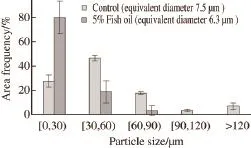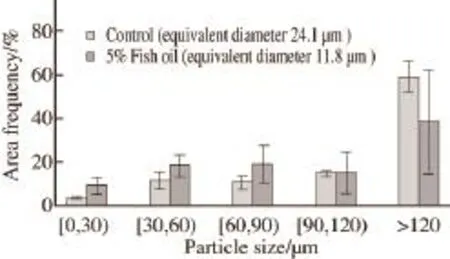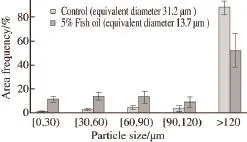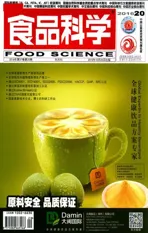Effects of Emulsifying Fish Oil on the Water-Holding Capacity and Ice Crystal Formation of Heat-Induced Surimi Gel during Frozen Storage
2016-11-07NIULiqiongHUYNHThiThuHuongJIARuGAOYuanpeiNAHONakazawaKAZUFUMIOsakoEMIKOOkazaki
NIU Liqiong, HUYNH Thi Thu Huong, JIA Ru, GAO Yuanpei, NAHO Nakazawa, KAZUFUMI Osako, EMIKO Okazaki
(Department of Food Science and Technology, Tokyo University of Marine Science and ↱Technology, Kogan 4-5-7, Minato-ku, Tokyo 108-8477, Japan)
Effects of Emulsifying Fish Oil on the Water-Holding Capacity and Ice Crystal Formation of Heat-Induced Surimi Gel during Frozen Storage
NIU Liqiong, HUYNH Thi Thu Huong, JIA Ru, GAO Yuanpei, NAHO Nakazawa, KAZUFUMI Osako, EMIKO Okazaki*
(Department of Food Science and Technology, Tokyo University of Marine Science and ↱Technology, Kogan 4-5-7, Minato-ku, Tokyo 108-8477, Japan)
This study was performed to evaluate the effects of emulsifying fish oil on the water-holding capacity (WHC) and ice crystal formation of heat-induced surimi gel during frozen storage. Alaska pollack surimi was ground with water and salt, mixed and emulsified with 5% fish oil, and prepared into gels by heat induction. The surimi gels were frozen by quick and slow freezing methods, and the gel quality was evaluated. The results showed that emulsified surimi gels displayed lower thawing drip and expressible drip compared to the control gel. Microscopic observation revealed that the sizes of ice crystals in the emulsified surimi gel stored for 3 months after freezing by quick and slow freezing methods were smaller than those of the control gels, 7.2 μm vs. 13.1 μm and 13.7 μm vs. 31.2 μm, respectively. These results indicated that the gel structure derived from emulsification of fish oil affected ice crystal formation and its frequency, consequently exerting a positive effect on the WHC of the gels during frozen storage.
heat-induced surimi gel; emulsification; frozen storage; water holding capacity (WHC); ice crystal
牛丽琼, HUYNH Thi Thu Huong, 贾茹, 等. 乳化鱼油对冻藏期间狭鳕鱼糜热凝胶持水性和冰结晶形成的影响[J]. 食品科学, 2016, 37(20): 293-298. DOI:10.7506/spkx1002-6630-201620049. http://www.spkx.net.cn
NIU Liqiong, HUYNH Thi Thu Huong, JIA Ru, et al. Effects of emulsifying fish oil on the water-holding capacity and ice crystal formation of heat-induced surimi gel during frozen storage[J]. Food Science, 2016, 37(20): 293-298. DOI:10.7506/ spkx1002-6630-201620049. http://www.spkx.net.cn
Frozen surimi is a tasteless fish-meat protein concentrate that contains myofibrillar proteins, which exhibit gel-forming ability. This concentrate is primarily used as an intermediate in the production of surimi-based products such as kamaboko,chikuwa, fish sausage, and crab-analogues[1]. Approximately 1.5 million metric tons of surimi-based products are believed to be produced annually worldwide[2]. Surimi-based products are very versatile; they can be mixed with other food materials or seasonings as consumer preference, or they can be consumed without cooking. Heat-induced gelation of myosin in surimi-based products results in the formation of a 3-dimensional network structure that holds water in a less mobile state, favoring the development of a stable gel[3]. Kamaboko is a traditional food that is typically consumed during the New Year in Japan, necessitating its commercial production ahead of time.
Freezing is an effective method for the preservation of perishable food materials with wide applicability in the food industry as well as in households. Freezing enables the longterm storage of kamaboko; additionally, this method has been employed to preserve kamaboko until it is transported to the market. Although freezing (and frozen storage) extends the shelf life of kamaboko, it has been shown negatively impact on its quality; for example, frozen kamaboko displays decreased water-holding capacity (WHC) and deterioration in physical properties, leading to a lowering of product quality. The formation of ice crystals, which may lead to irreversible changes, is believed to be the main cause of damage due to freezing. Jia et al.[4]reported a correlation between differences in the WHC of kamaboko and the freezing rate and storage conditions; moreover, changes in thawing drip were shown to correspond to the differences in ice crystal formation. The growth of ice crystals occurs during frozen storage and may lead to extensive physical changes and an increase in drip loss after thawing[5]; therefore, the decrease in quality could be attributed to the size and localization of ice crystals during the freezing process and during storage at freezing conditions[6].
Fish oil is an excellent source of long-chain polyunsaturated fatty acids such ↱as icosapentaenoic acid(IPA, 20:5 n-3) and docosahexaenoic acid (DHA, 22:6 n-3)[7]. Consumption of adequate amounts of fish oil has been shown to positively impact brain development and reduce inflammation and cardiovascular disease[8]. The past decade has seen a development of emulsion-based products by adding fish oil. The addition of fish oil to surimi was generally considered to decrease the quality of surimi gel and its WHC. However, Okazaki et al.[9]reported that fish oil could be stabilized by emulsification with surimi, if added gradually with vigorous mixing. This method ensured complete mixing of the fish oil with surimi, yielding a smooth, paste-like material. Additionally, vigorous mixing of surimi with fish oil improved the gel-forming ability and the WHC of surimi owing to the formation of fine oil ↱droplets during emulsification[10]. Based on the positive effects of emulsifying fish oil on the improved quality of the heatinduced surimi gel, it was surmised that there would be a similar positive effect on the WHC of frozen heat-induced surimi gel by minimizing the damage caused by freezing and frozen storage. However, research on the effect of emulsifying fish oil on the quality of heat-induced surimi gel during frozen storage is scarce.
Our aim was to determine the effect of emulsifying fish oil on the WHC and ice crystal formation of heat-induced surimi gel during frozen storage. Accordingly, the changes of thawing drip, expressible drip, ice crystal average size and frequency during frozen storage were assessed.
1 Materials and Methods
1.1 Raw material and additives
FA-grade frozen surimi from Alaska pollack (Theragra chalcogramma) Ocean Phoenix; Maruha Nichiro Corporation, Osaka, Japan) was used as the raw material. A 10 kg frozen surimi block was cut into 600 g portions, vacuum-packed in a plastic bag, and stored at -30 ℃ until used. Fish oil (27 W;Maruha Nichiro Corporation, Osaka, Japan) containing more than 99% triglyceride, 25% DHA, and 5% IPA (melting point = 0 ℃) was also stored at -30 ℃ until used.
1.2 Methods
1.2.1 Preparation of emulsified heat-induced surimi gel
Frozen surimi was thawed at -3 ℃ overnight, and cut into small pieces (~1 cm cubes). Surimi cubes were placed in a refrigerated vacuum mixer (Model UMC 5E;Stephan Machinery Corp., Hamelin, Germany) connected to a circulating chiller maintained at a - 2 ℃ (Model C-503;Sibata Instruments, Saitama, Japan). Emulsified heat-induced surimi gel was produced and processed using a method described by Okazaki et al.[9]. Water was added to the surimi cubes, and the cubes were ground at 1 500 r/min for 1 min;this mixture was ground with NaCl (3% m/m) at 1 500 r/min for 1.5 min. Subsequently, the surimi was vigorously mixed with 5% fish oil by increasing the centrifugal speed from 300 to 3 000 r/min (300 r/min for 60 s; 600, 900, 1 200, and 1 500 r/min for 30 s; 1 800 and 2 100 r/min for 15 s; and 2 400, 2 700, and 3 000 r/min for 10 s under vacuum), inorder to emulsify the fish oil. The control sample (without fish oil) was also chopped under vacuum with vigorous stirring. The temperature of the surimi paste was maintained below 10 ℃ while chopping. Emulsified surimi paste was stuffed into a polyvinylidene chloride casing tube (length, 30 cm;diameter, 25 mm; Kureha Chemical Industry Co. Ltd., Tokyo, Japan); both ends of the tube were tightly sealed, and the tube was heated at 90 ℃ for 30 min in a water bath. The heatinduced cylindrical gels were immediately cooled in iced water for 30 min, the casing tube was removed, and the gels were cut into 25 mm (length) pieces.
1.2.2 Freezing and thawing
Heat-induced gel pieces were packaged in plastic bags (Seisannipponsha Ltd., Tokyo, Japan) under vacuum and frozen by the liquid immersion (quick freezing) or the air freezing (slow freezing) methods. Liquid immersion freezing was performed by placing the packed gel in cooled ethanol solution at -20 ℃[11], and air freezing was performed by placing the vacuum-packed samples directly in the refrigerator (-20 ℃). The frozen samples were stored in the refrigerator for 3 months. Subsequently, they were thawed by refrigeration at 4 ℃ overnight.
1.2.3 Determination of WHC
The WHC of the gel was determined by the amount of thawing drip and expressible drip. The thawing drip was calculated as a percentage of the initial weight of the sample. The expressible drip content was determined using a method proposed by the Codex Alimentarius Commission[12]. Cylindrical gel samples were cut in thin slices weighing approximately 1 g (weight range, 0.975-1.025 g; diameter, 23 mm). The slices were weighed and placed between two Whatman filter papers (No. 2A and No. 4A; Whatman International Ltd., Maidstone, UK) both above and below the sample (No. 4A on the inner side, No. 2A on the outer side). The sample was pressed at 10 kg/cm2for 20 s, extricated from the filter papers, and re-weighed. The expressible drip content was calculated from the difference in weight before and after compression and was expressed as a percentage of the sample weight.
1.2.4 Moisture content in surimi gel
The moisture content of heat-induced surimi gel was determined using a method described by the Association of Official Analytical Chemists (1990)[13].
1.2.5 Evaluation of ice crystal formation
Ice-crystal formation and size frequency were evaluated using an optical microscope. Samples stored in a freezer for 1 or 3 months were cut into 5 mm cubes and directly fixed in 10% formalin at -20 ℃ for 5 weeks[14]. The fixed samples were embedded in gelatin and the FSC22 frozen section compound (Leica Microsystems Corp., Richmond, USA) and sliced into 10 μm-thick sections in a Cryostat(CM-1500; Leica Microsystems Corp, Wetzlar, Germany). An adhesive film (Section-Lab Co. Ltd., Hiroshima, Japan)was attached to the surface of the sections. The sections were maintained at -20 ℃ throughout this procedure. The sections were stained with 1% eosin solution (Wako Pure Chemical Industries, Osaka, Japan) for 60 s, washed in distilled water for a few seconds, and air-dried at room temperature. The frozen sections were mounted on microslides with two drops of SCMM G1 Super Cryomounting medium (Section-Lab Co. Ltd., Hiroshima, Japan)[15]and observed under a BZ-9000 microscope (Leica Microsystems Corp, Wetzlar, Germany). The ice crystals were analyzed using a commercial image processing and analysis software (WinROOF v.6.5.3;Mitani Corp., Tokyo, Japan). The equivalent diameters and frequency of ice crystals were calculated from these images. The area frequency of the ice crystals was calculated using the following equation:

Where S refers to selected range area/μm2; T refers to total area/μm2.
1.3Statistical analysis
The data are presented as meandeviations of samples treated using each method (n=4). The effect of emulsifying fish oil on all measurements was analyzed by one-way analysis of variance (ANOVA). Differences were regarded as significant at P < 0.05. Tukey and Duncan's differences were reported for all figures. The data was analyzed using SPSS software for Windows (v. 17.0; IBM, Armonk, NY, USA).
2 Results and Analysis
2.1Changes in WHC
Changes in drip loss of control and the emulsified gel prepared using the quick freezing and slow freezing method and stored for 3 months are presented in Fig. 1 and Fig. 2. Emulsified gels prepared by two freezing methods both presented lower drip loss compared to the control during frozen storage.

Fig.1 Changes of drip loss with quick freezing heat-induced gel during frozen storage

Fig.2 Changes of drip loss with slow freezing heat-induced gel during frozen storage
The WHC indicates the ability of a gel to physically entrap large amounts of water in a manner that inhibits exudation in the presence of an external or gravitational force. It has a considerable effect on food quality[16]. A decrease in the WHC results in a corresponding decrease in food quality during frozen storage, which, in turn, influences consumer choice[17]. Drip loss in the thawed gel is an important parameter that reflects the quality. Fig. 1 and Fig. 2 indicate that the change in thawing drip is greater than that in expressible drip during frozen storage. Previous study by Fukushima et al.[18]indicated WHC of heat-induced emulsified surimi gel before freezing became higher comparing with the gel without adding fish oil. These results corroborate the results of the previous study, which proposed that this might be indicative of changes in the structure and WHC of the gel[19].
Samples frozen using the slow freezing method exhibited a higher drip loss during the entire storage period compared to samples prepared using the quick freezing method. Emulsified slow frozen samples exhibit greater thawing drip 2.12% than emulsified quick frozen samples 0.88% after 1 month frozen storage. Water in the frozen gel migrates from its original location to form ice crystals. Thus, water is not absorbed at its original location after thawing. Therefore, an increase in the storage period showed a corresponding increase in the thawing drip in all samples, suggesting that freezing induces a change in the WHC that destroys the gel structure to some extent. Previous studies have reported that slow freezing induces lesser nucleation of water; subsequently, the net structure cannot sustain the water owing to the formation of large ice crystals. This results in an easier release of water after thawing[20]. In this study, emulsified gels prepared by both the slow and quick freezing methods exhibited lower thawing drip than the controls. We hypothesized that the oil-protein interaction could confer a higher WHC to the emulsified gel. Previous studies have also suggested that oil particles may fill the empty spaces of a gel matrix, thereby stabilizing the matrix against movement[21].
The effect of emulsifying fish oil on the WHC of gels was further confirmed by analyzing the content of water and other components released during the thawing of the frozen gel. Analysis of the oil content in the thawing liquid and the ratio of released water to the total water content revealed that oil was sustained in the matrix after thawing; less than 0.8% oil was released from each gel. Control surimi gels stored for 3 months after freezing by the quick and slow freezing methods released a greater percentage of water compared to emulsified gels (released water ratios: 6.2% vs. 5.1% and 9.0% vs. 5.6%, respectively). This indicated that the water retention capacity of emulsified surimi gel was greater than that of the control.
The filter paper-pressing method has been extensively used to measure the WHC because of its simplicity and reliability. Additionally, Akahane et al.[22]has reported that this method could be a reliable and easy standard that could be used to reflect the stability of water in kamaboko. The addition of 5% fish oil to emulsified surimi gel led to a decrease in expressible drip during the frozen storage period, particularly in the slow freezing sample. However, this was contrary to the popular opinion that the addition of liquid into surimi would increase the expressible water content. Shi Liu et al.[23]reported that the addition of vegetable oil to surimi gel led to a corresponding significant increase in expressible drip compared to the control (P < 0.05). We theorized that the strong mixing conditions could have converted the oil into fine particles that filled the gel network, thereby preventing ice crystal growth during frozen storage. Oil particles in the surimi gel were less than 10 μm in diameter. However, the underlying mechanism for the positive effect of emulsifying fish oil on the WHC of gel during frozen storage need further studied.
2.2Ice crystal formation
Light microscopic images of the frozen samples arepresented in Fig. 3. Micrographs of ice crystals in surimi gel frozen using different freezing methods were observed. Pink sections indicate the network position after protein staining, while the white portions indicate the placement of ice crystals after fixing. Figs. 4-7 summarize the statistical analysis of the size and frequency of ice crystals formed during storage periods. Each figure also presents the average equivalent diameter of ice crystals formed.

Fig.3 Light micrographs of heat-induced surimi gels during frozen storage

Fig.4 Average ice crystal equivalent diameter and area frequency of heat induced surini gel with quick freezing after 1 month frozen storage

Fig.5 Average ice crystal equivalent diameter and area frequecy of surimi gel with slow freezing after 1 month frozen storage

Fig.6 Average ice crystal equivalent diameter and area frequecy of surimi gel with quick freezing after 3 months frozen storage

Fig.7 Average ice crystal equivalent diameter and area frequecy of surimi gel with slow freezing after 3 months frozen storage
The size and frequency of ice crystals are important parameters reflecting the quality of frozen products. The final sizes of the ice crystals are influenced by the rates of nucleation and ice crystal growth, along with the final temperature. Higher freezing rates result in the formation of a greater number of nuclei, while limiting the final crystal size. The ice crystals formed during storage were smaller in the emulsified gel samples than in the control gels. Larger ice crystals were detected in samples prepared by the slow freezing method. This could be explained by the proximity of the temperature to the solid-liquid equilibrium curve for a long freezing time; this results in a lower rate of nucleation, leading to the formation of a lower number of nuclei and, subsequently, larger crystal sizes[20].
Emulsified gels by quick freezing and slow freezing stored for 3 months showed ice crystals with a lower average equivalent diameter (7.2 μm and 13.7 μm) than the controls(13.1 μm and 31.2 μm). Emulsified gels frozen by the quick freezing method also showed no significant increase in ice crystal size after 1 and 3 months of frozen storage(P < 0.05). The ice crystallization controlled microstructures of solids which influenced shrinkage upon thawing[24]. This also suggested that stored emulsified gels prepared by the quick freezing method were of higher quality.
The WHC of control samples was lower than that of emulsified surimi gels, which corresponded to the formation of large ice crystals, damage to the gel structure, and water leakage. Therefore, water was easily released from the gel matrix, particularly with an increase in frozen storage period[25]. The observations using light microscopy and our subsequent calculations were in accordance with our observations on the positive WHC for emulsified surimi gels.
3 Conclusionusion
The addition of 5% fish oil to surimi and subsequent vigorous mixing, heating, and freezing could induce the formation of smaller ice crystals as compared to those in control gels during the 3-month frozen storage period. In particular, emulsifying fish oil prevented the growth of ice crystal during frozen storage and improved the WHC of heat-induced surimi gel as compared to that of the control. Emulsified heat-induced surimi (particularly, gels treated with the slow freezing method) and control gels showed significant differences in drip loss. Heat-induced surimi gel mixed with 5% fish oil improved the WHC of the gel after frozen storage. The results indicated that emulsifying fish oil could effectively minimize the damage caused by freezing in frozen heat-induced surimi gels.
ences:
[1] OKAZAKI E, KIMURA I. Frozen surimi and surimi-based products[M]// In seafood processing: technology, quality and safety. West Sussex: IFST, 2014: 209-235. DOI:10.1002/9781118346174.ch9.
[2] PASCAL G. In Surimi market update 2012[C]//The 12thSurimi Industry Forum Oregon State University, 2012: 40-42.
[3] ISHIOROSHI M, JIMA K S, YASUI T. Heat-induced gelation of myosin: factors of pH and salt concentrations[J]. Journal of Food Science, 1979, 44(5): 1280-1284. DOI:10.1111/j.1365-2621.1979. tb06419.x.
[4] JIA R, NAKAZAWA N, OSAKO K, et al. Effect of freezing conditions on the quality of heat-induced surimi gel[C]//The 2ndEAFTA Conference, 2014: 88.
[5] SUN D W. Handbook of frozen food processing and packaging[M]. Florida: CRC Press, 2011.
[6] SCOTT E, HELDMAN D. Simulation of temperature dependent quality deterioration in frozen foods[J]. Journal of Food Engineering, 1990, 11(1): 43-65. DOI:10.1016/0260-8774(90)90038-A.
[7] SIRIWARDHANA N, KALUPAHANA N S, MOUSTAIDMOUSSA N. Health benefits of n-3 polyunsaturated fatty acids:eicosapentaenoic acid and docosahexaenoic acid[M]. Oxford:Elsevier Inc., 2012: 211-222.
[8] KRIS-ETHERTON P M, HARRIS W S, APPEL L J. Fish consumption, fish oil, omega-3 fatty acids, and cardiovascular disease[J]. Circulation, 2002, 106(21): 2747-2757. DOI:10.1161/01. CIR.0000038493.65177.94.
[9] OKAZAKI E, YAMASHITA Y, OMURA Y. Emulsification of fish oil in surimi by high-speed mixing and improvement of gelforming ability[J]. Nippon Suisan Gakkaishi, 2002, 68(4): 547-553. DOI:10.2331/suisan.68.547.
[10] OKAZAKI E, NODA S, FUKUSHIMA H, et al. Improvement of the physical properities of heat-induced surimi gel by fish oil emulsification[J]. Nippon Suisan Gakkaishi, 2006, 72(6): 1093-1098. DOI:10.2331/suisan.72.1093.
[11] KIANI H, ZHANG Z, SUN D W. Effect of ultrasound irradiation on ice crystal size frequency in frozen agar gel samples[J]. Innovative Food Science and Emerging Technologies, 2013, 18: 126-131. DOI:10.1016/j.ifset.2013.02.007.
[12] Codex alimentarius commission: procedural manual[S]. FAO, 2008.
[13] HELRICH K. Official methods of analysis of the AOAC[S]. Rirginia:Association of Official Analytical Chemists Inc., 1990.
[14] SUZUKI T. Freeze substitution method for observation of ice crystal morphology in frozen food[J]. Refrigeration, 2008, 83(965): 143-148.
[15] KAWAMOTO T. Use of a new adhesive film for the preparation of multi-purpose fresh-frozen sections from hard tissues, whole-animals, insects and plants[J]. Archives of Histology and Cytology, 2003, 66(2): 123-143. DOI:10.1679/aohc.66.123.
[16] DAMODARAN S, PARKIN K L, FENNEMA O R. Fennema's food chemistry[M]. Florida: CRC Press, 2007.
[17] LAN Y, SHANG Y, SONG Y, et al. Changes in the quality of superchilled rabbit meat stored at different temperatures[J]. Meat Science, 2016, 117: 173-181. DOI:10.1016/j.meatsci.2016.02.017.
[18] FUKUSHIMA H, OKAZAKI E, NODA S, et al. Changes in physical properties, water holding capacity and color of heat-induced surimi gel prepared by emulsification with fish oil[J]. Journal of the Japanese Society for Food Science and Technology, 2007, 54(1): 39-44. DOI:10.3136/nskkk.54.39.
[19] LIU W, LANIER T C. Rapid (microwave) heating rate effects on texture, fat/water holding, and microstructure of cooked comminuted meat batters[J]. Food Research International, 2016, 81: 108-113. DOI:10.1016/j.foodres.2016.01.005.
[20] MARTINO M N, OTERO L, SANZ P, et al. Size and location of ice crystals in pork frozen by high-pressure-assisted freezing as compared to classical methods[J]. Meat Science, 1998, 50(3): 303-313. DOI:10.1016/S0309-1740(98)00038-2.
[21] DICKINSON E J C. Heat-set whey protein emulsion gels:role of active and inactive filler particles[J]. Journal of Dispersion Science and Technology, 1999, 20(1/2): 197-213. DOI:10.1080/01932699908943787.
[22] AKAHANE Y, SHIMIZU Y. Classification of the existing state of water in kamaboko by expressing, absorbing, and thermogravimetric methods[J]. Nippon Suisan Gakkaishi, 1988, 54(7): 1237-1241. DOI:10.2331/suisan.54.1237.
[23] SHI L, WANG X F, CHANG T, et al. Effects of vegetable oils on gel properties of surimi gels[J]. LWT-Food Science and Technology, 2014, 57(2): 586-593. DOI:10.1016/j.lwt.2014.02.003.
[24] HARNKARNSUJARIT N, KAWAI K, SUZUKI T. Impacts of freezing and molecular size on structure, mechanical properties and recrystallization of freeze-thawed polysaccharide gels[J]. LWTFood Science and Technology, 2016, 68: 190-201. DOI:10.1016/ j.lwt.2015.12.030.
[25] HUNT A, PARK J. Comparative study of sodium bicarbonate on gelling properties of alaska pollock surimi prepared at different freezing rates[J]. Journal of Food Quality, 2014, 37(5): 349-360. DOI:10.1111/jfq.12099.
乳化鱼油对冻藏期间狭鳕鱼糜热凝胶持水性和冰结晶形成的影响
牛丽琼,HUYNH Thi Thu Huong,贾 茹,高元沛,中澤奈穂,大迫一史,岡﨑惠美子*
(国立大学法人東京海洋大学食品科学技术学院,港区港南4-5-7,东京 108-8477,日本)
评估乳化鱼油对冻藏期间狭鳕鱼糜热凝胶持水性和冰结晶形成的影响。鱼糜经盐擂后,加入5%鱼油经乳化制得乳化鱼糜热凝胶。随后用快速冻结和慢速冻结2 种方式冻结样品并评估其在冻藏期间热凝胶品质的变化。研究结果表明:与对照相比,乳化热凝胶在冻藏期间的解冻损失和压榨损失均有降低。显微观察结果显示经3 个月冻藏后乳化热凝胶内的冰结晶平均粒径与其对照相比均有减小,其中快速冻结乳化样品为7.2 μm,对照样品为13.1 μm,慢速冻结乳化样品为13.7 μm,对照样品为31.2 μm。以上结果表明乳化鱼油可能对冻藏期间的热凝胶的冰结晶形成和其分布的影响而导致其持水性不同。
热鱼糜凝胶;乳化;冻藏;持水性;冰结晶
S986.1
A
2016-04-29
牛丽琼(1991—),女,硕士研究生,研究方向为乳化狭鳕鱼糜的加工与利用。E-mail:niuliqiongnlq@163.com
岡﨑惠美子(1954—),女,教授,博士,研究方向为水产品鲜度和乳化鱼糜加工与利用。
10.7506/spkx1002-6630-201620049
E-mail:eokazaki@kaiyodai.ac.jp
